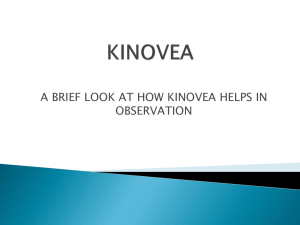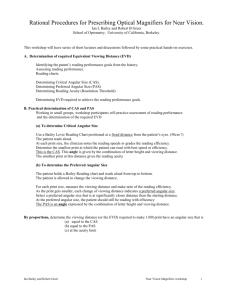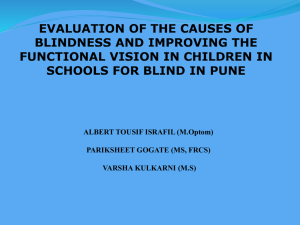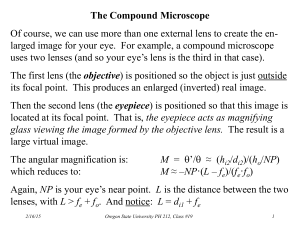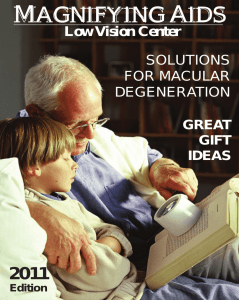Low vision Aid
advertisement
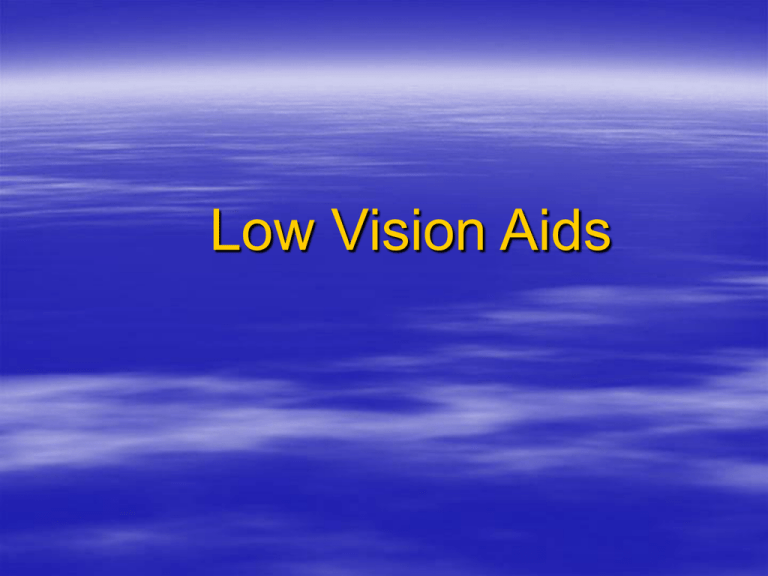
Low Vision Aids Who are all low vision patient Having vision less than 6/18 in better eye Having vision 6/6 but field of vision is less than 20 Having vision 6/6, field of vision is normal, but contrast sensitivity is poor Who need rehabilitation? Patient having some vision that patients need LV device Patient having less than 3/60, that patient wants mobility training Causes Macular degeneration Diabetic Retinopathy Glaucoma Corneal disease Neurological disorders Albinism RP Optic atrophy Achromatopsia Retinal problems Low vision Examination Case History RR Field Contrast sensitivity Glare Trial of low vision device Instruction Prescription Follow-up Treatment Optical aids Non-optical aids Electronic aids Magnification Relative size magnification – Physically enlarging the size of an object of the retina Relative distance magnification – Moving the object of regards towards the patient Angular magnification Ratio of the angle of substance of the image formed by an optical instrument compared to the actual object . E.g.. Telescope Optical Aids Telescope Spectacle Hand Magnifier Stand Magnifier Pocket Magnifier Prismosphere Distance vision Telescopes – Galilean – Keplerian Galilean + Objective, - eye piece Low power ( 2 x to 4x ) Lighter, less expensive Large exit pupil Keplarian + objective, + eye piece Prism to invert image Higher powers available Poor light gathering Types Hand held telescopes Clip on telescopes Spectacle mounted telescopes Hand held Portable Spotting intermediate & distance Monocular Inexpensive Clip on 2.5 x to 4 x Distance and near Some hand held can be placed in flip-up clip Spectacle mounted 1.7x to 8x Special order Bioptic Full diameter Wide angle Expanded field when compared to others It is also available head down type Advantages of telescopes Distance, intermediate or near Variable working distance Monocular & binocular Spectacle mounted and hand held Ideal range -2x to 4x Disadvantage in Telescope Disadvantages – Restricted field – Reduced light gathering – Limited depth of focus – Requires co-ordination – Appearance and cost factor Problems with optical system Small field of view When magnification increases contrast will be decrease Close working distance Lighting and glare More aberrations Optical aids available here Telescope 3x; 4x 2x hand held magnifier 2x bar magnifier 3x hand held illuminated magnifier Pocket magnifier ( 3x, 6x) 5.0 ds hand held illuminated magnifier 4x wide field stand magnifier 6x cutaway stand magnifier Kesten baum’s rule The inverse of the visual acuity = the add required to read 1m point 6/60 = +10.0 ds Spectacle Advantages – Hands free – Wide field – Prolonged reading – Monocular or binocular Disadvantages Fixing reading distance Close reading distance Positioning and posture Head pain Hand Magnifiers Advantages – Variable eye lens distance – Normal reading distance – Allows for eccentric viewing – May have own light source – Ideal range 10 to 20 dpts Hand Magnifier Disadvantages – Reduced field of view – Both hands occupied – Critical focus distance – Motion magnified ( tremor, arthritis ) – Illumination reflected Stand Magnifiers Advantages – May have own light source – Lens distance stabilized on page – Ideal for stroke, tremor, arthritis patients – Ideal stand range 12 – 24 dpts – Illuminated stand range 16 to 28 dpts Stand Magnifiers Disadvantages – Reduced field of view – Requires co-ordination – Need to use appropriate glasses – Illumination blocked and reflected by lens – Not be a portable Prism sphere glasses Advantages +5.0 ds & 6.0 ds, 8.0ds prismospheres 4x dome magnifier Aspheric, +16.0 ds, +22.0 ds, +24.0 ds 2.5 stand magnifier Disadvantages Very close Reading Standard reading distance Non Optical Aids Tints Illumination fluorescent lamp – Incandescent – Neodymium bulb – Halogen light Contrast – Black pen – Typo scope ( black & white contrast ) Money finder Electronic aids CTV – closed circuit televisions allow printed hand written and graphic material to be electronically displayed, magnified and enhanced on a television monitor. Contrast can be increased and the image polarity reversed allowing white letters to be displayed on a black back ground or the reverse. Patients also have a choice of color displatts. How to prescribe reading glairs Best refraction Give correct add power for near Make sure patient is reading at correct distance See it lighting helps Try their own reading material (eg) newspaper Are prisms needed If the patient is monocular – No prism needed – Occlude fellow eye if it interferes – V/A is poor

